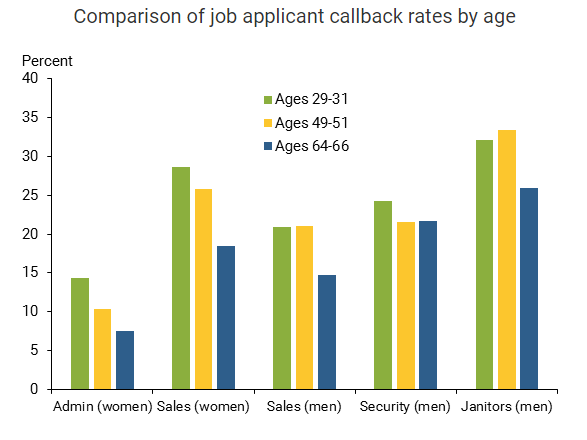Aging Society
The Job Market is Booming for Older Workers

Source:Shutterstock
With the structure of population aging, the projected share of people aged 65 and over in the job market is projected to rise sharply.
Views
The Job Market is Booming for Older Workers
By Briony Harrisweb only
We’re living for longer, and an ageing population will cause significant public policy challenges unless we work for longer as well.
Many countries are adjusting the age of their state pensions upwards – throwing the onus back onto the individual to support themselves financially for longer.
While age discrimination can undeniably still be a problem, many firms are now actively looking at ways of reintegrating older workers into their workforce. And they are finding that by doing so, they are gaining access to a huge pool of untapped talent.
 Image: US Census Bureau (2014), via the Federal Reserve Bank of San Francisco
Image: US Census Bureau (2014), via the Federal Reserve Bank of San Francisco
In coming decades, the projected share of people aged 65 and over in the US working-age population is projected to rise sharply – from about 19% currently to 29% in the year 2060. At that point it also approaches equality with the shares of workers who are aged 25-44 and 45-64.
Barclays, Ford and the consultancy firm Booz Allen Hamilton are amongst firms in the US with specific schemes to encourage older workers back into the workforce. Many of these workers have relevant experience and skills but have found themselves outside the labour force for a variety of reasons.
It may even prove to be financially advantageous to deliberately seek out such workers, according to a recent paper which shows that workers from outside the existing workforce are about 25% cheaper than poaching a similar employee from another company.
“It makes sense for firms to go after non-participants,” as they are less likely to set off wage-bidding by seeking counter offers, Aysegul Sahin, one of the paper’s co-authors, told Bloomberg.
Shorter Working Weeks
In the UK, the government’s business champion for older workers has challenged employers throughout the UK to increase older workers in the workforce by 12% by 2022. That will result in a million more 50 to 69 year olds who want to work being able to.
 Sydney Prior worked at a DIY store in the UK until he was 95. (Image: Reuters/Simon Newman)
Sydney Prior worked at a DIY store in the UK until he was 95. (Image: Reuters/Simon Newman)
Mexico’s telecoms billionaire Carlos Slim has suggested working lives could carry on until 75 by putting employees on a three-day week. While in Japan – which has the fastest ageing population in the world – companies are gradually beginning to raise the retirement age above 60.
The plight of older workers – and the enthusiasm from companies to embrace them – is aided by historically low unemployment and a shortage of skilled labour, most notable in the US, UK and Japan.
Testing for Bias
However, the picture is not all rosy for workers above 50 who are looking for jobs.
Establishing evidence of age discrimination is not straightforward, but the Federal Reserve of San Francisco has done a significant and revealing piece of work on the matter.
It created realistic but fictitious resumes for young, middle-aged and older job applicants and submitted them to actual job adverts for administrative assistants, retail sales jobs and security guards. These triplicate job applications were then sent to more than 13,000 positions in 12 US cities.
The results are clearly seen in the chart below: The call back rates were higher for younger applicants and lower for older applicants, clearly highlighting a trend towards age discrimination when hiring.

Progress has been made – and is still being made – in overcoming workplace discrimination in areas such as race, gender and sexuality. Barriers are broken down by proving talent and ability, and this will no doubt be the case as a critical mass of older people make up a greater part of the workforce for longer.
As many Western countries grapple with the so-called dependency ratio problem – or the increased ratio of non-workers to workers in society – finding new ways to embrace an older workforce is set to become ever more crucial.
Additional Reading
♦ The Home Care Medical Revolution
♦ Preparing for the Golden Years
♦ Sheu Fang-yi: Setback Sets Stage for Fulfilling Life After 40
Original content can be found at the website of World Economic Forum.
♦ The job market is booming for older workers
This article is reproduced under the permission of World Economic Forum (WEF) and terms of Creative Commons Attribution-NonCommercial-NoDerivs 4.0 Unported License (“CCPL”). It presents the opinion or perspective of the original author / organization, which does not represent the standpoint of CommonWealth magazine.







